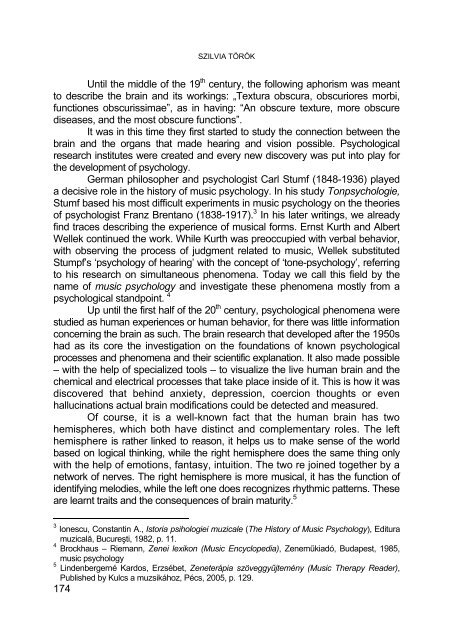musica - Studia
musica - Studia
musica - Studia
You also want an ePaper? Increase the reach of your titles
YUMPU automatically turns print PDFs into web optimized ePapers that Google loves.
SZILVIA TÖRÖK<br />
Until the middle of the 19 th century, the following aphorism was meant<br />
to describe the brain and its workings: „Textura obscura, obscuriores morbi,<br />
functiones obscurissimae”, as in having: “An obscure texture, more obscure<br />
diseases, and the most obscure functions”.<br />
It was in this time they first started to study the connection between the<br />
brain and the organs that made hearing and vision possible. Psychological<br />
research institutes were created and every new discovery was put into play for<br />
the development of psychology.<br />
German philosopher and psychologist Carl Stumf (1848-1936) played<br />
a decisive role in the history of music psychology. In his study Tonpsychologie,<br />
Stumf based his most difficult experiments in music psychology on the theories<br />
of psychologist Franz Brentano (1838-1917). 3 In his later writings, we already<br />
find traces describing the experience of <strong>musica</strong>l forms. Ernst Kurth and Albert<br />
Wellek continued the work. While Kurth was preoccupied with verbal behavior,<br />
with observing the process of judgment related to music, Wellek substituted<br />
Stumpf’s ‘psychology of hearing’ with the concept of ‘tone-psychology’, referring<br />
to his research on simultaneous phenomena. Today we call this field by the<br />
name of music psychology and investigate these phenomena mostly from a<br />
psychological standpoint. 4<br />
Up until the first half of the 20 th century, psychological phenomena were<br />
studied as human experiences or human behavior, for there was little information<br />
concerning the brain as such. The brain research that developed after the 1950s<br />
had as its core the investigation on the foundations of known psychological<br />
processes and phenomena and their scientific explanation. It also made possible<br />
– with the help of specialized tools – to visualize the live human brain and the<br />
chemical and electrical processes that take place inside of it. This is how it was<br />
discovered that behind anxiety, depression, coercion thoughts or even<br />
hallucinations actual brain modifications could be detected and measured.<br />
Of course, it is a well-known fact that the human brain has two<br />
hemispheres, which both have distinct and complementary roles. The left<br />
hemisphere is rather linked to reason, it helps us to make sense of the world<br />
based on logical thinking, while the right hemisphere does the same thing only<br />
with the help of emotions, fantasy, intuition. The two re joined together by a<br />
network of nerves. The right hemisphere is more <strong>musica</strong>l, it has the function of<br />
identifying melodies, while the left one does recognizes rhythmic patterns. These<br />
are learnt traits and the consequences of brain maturity. 5<br />
3 Ionescu, Constantin A., Istoria psihologiei muzicale (The History of Music Psychology), Editura<br />
muzicală, Bucureşti, 1982, p. 11.<br />
4 Brockhaus – Riemann, Zenei lexikon (Music Encyclopedia), Zeneműkiadó, Budapest, 1985,<br />
music psychology<br />
5 Lindenbergerné Kardos, Erzsébet, Zeneterápia szöveggyűjtemény (Music Therapy Reader),<br />
Published by Kulcs a muzsikához, Pécs, 2005, p. 129.<br />
174

















